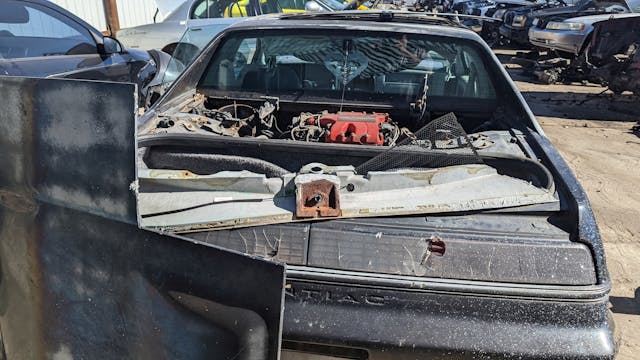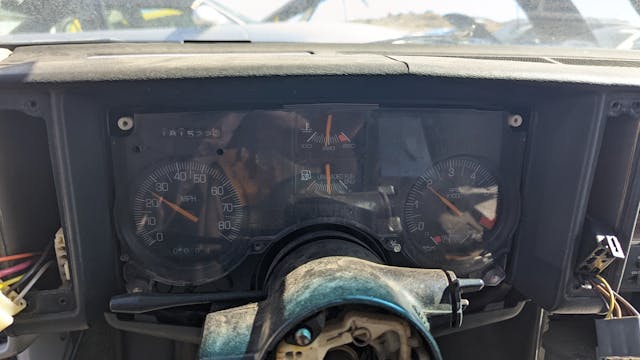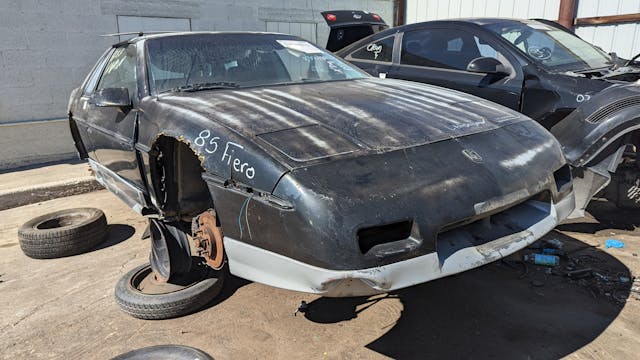Final Parking Space: 1985 Pontiac Fiero GT
Pontiac went from being the affordable-yet-stodgy GM division to the youth-centric division with brilliant marketing and engineering under John Z. DeLorean during the 1960s, and enough of that spirit survived into the 1980s to allow for the development of a radical, mid-engined Pontiac two-seater. That car was the Fiero, and I’ve found this loaded ’85 GT in a self-service boneyard just south of Denver.

The Fiero debuted as a 1984 model, the same year as the groundbreaking C4 Corvette. I was in my senior year of high school at the time, and I don’t recall nearly as much excitement among my peers over Pontiac’s new two-seater as for the first Corvette to handle like a true sports car.

Pontiac was denied a two-seat sports car in the 1960s, though Pontiac’s XP-833 Banshee prototype went on to contribute design elements to the C3 Corvette and the Opel GT. By the late 1970s, though, times seemed right for a lightweight, mid-engined sports car from Pontiac that could help GM meet Corporate Average Fuel Economy standards.

During a very lengthy and not-so-well-funded development period, the Fiero ended up being based on a unibody spaceframe onto which plastic body panels were bolted. This resulted in a very sturdy structure and a rustproof body, but the combination weighed hundreds of pounds more than the designers would have preferred.

There was no way GM was going to kick loose the funds to develop a new engine just for one low-volume affordable car, and the same ended up being true for the transaxle and suspension.

For its debut year, the only engine available in the Fiero was the 2.5-liter Iron Duke pushrod straight-four, known as the Tech IV when equipped with throttle-body fuel injection (as was the case with the Fiero). It was cheap to build—thanks to sharing much tooling with the Pontiac 301 V-8—and reliable, but it didn’t like to spin and it generated just 92 horsepower and 132 pound-feet of torque. Not exactly ideal for a sporty car, especially one that had to compete against two-seat competition that included the Honda Civic CRX, Toyota MR2, and Ford EXP/Mercury LN7.

For 1985, a 2.8-liter pushrod V-6 became available in the Fiero. It was rated at 130 horsepower and 160 pound-feet, and it resulted in a respectably quick car. This is a GT (or a regular Fiero with GT parts swapped in; the build tag was scraped off), so it came with the V-6 as standard equipment.

The reason that the Tech IV and 2.8 V-6 were the only two Fiero engine choices is a simple one: the transaxle and rear suspension in the Fiero were borrowed from the front of the GM X-body, best known as the platform beneath the Chevrolet Citation, and those are the engines used in the X family. The front suspension for the 1984–87 Fiero came from the Chevrolet Chevette, because it was cheap and available.

For the 1988 model year, the Fiero got a bespoke new suspension that ditched the Citation and Chevette stuff and improved the car’s handling. The change didn’t help sales much, as the American car-buying public remembered the widely publicized engine fires and recalls of the 1984 and 1985 cars. 1988 was the final year for the Fiero.

This one is loaded with expensive options, including the $475 three-speed automatic transmission ($1389 in 2024 dollars) and the $750 air conditioning ($2193 after inflation). The MSRP for the 1985 Fiero GT was $11,795, or $34,481 in today’s money; the entry-level 1985 Fiero started at $8495 ($24,834 now).

The Fiero wasn’t what you’d call a success story for GM, but the good news today is that the Fiero has long been an affordable and versatile enthusiast machine. In my role as wise and dignified Chief Justice of the 24 Hours of Lemons Supreme Court, I’ve seen plenty of Fieros on road-race courses and they can be fast if set up properly and well-driven. In fact, 1984–87 models with ordinary 2.8s get around the track just as well as the 1988s, and they’re reliable once you sort out the X-body axle/hub bugs.

The removable plastic body panels mean that you can convert a Fiero into a “Fierrari” or a “Fieroborghini” if you so choose, and an entire universe of GM engines can be swapped in without too much difficulty.
***
Check out the Hagerty Media homepage so you don’t miss a single story, or better yet, bookmark it. To get our best stories delivered right to your inbox, subscribe to our newsletters.













In the summer of ’83, just a year out of Michigan State and working for Holley Carburetor, I special ordered my ’84 Fiero (red with tan interior).
When it finally arrived, the next day I proudly drove into the Holley employee parking lot. Soon a crowd of “car guys” (and some welcomed young ladies) surrounded the car, ogling over the “new” features. I was never prouder.
As with most things in life, the novelty wore off, especially when I experienced:
How slow it was (just 30 more hp’s than a beetle),
Each time you turned your head you got the stereo blasting in one ear (speakers in the headrests)
The front end was too light. On .25 in. of snow you could turn the wheel and the car went straight
Constant cooling leaks
But it served its purpose; for $13k I could pretend I was Magnum PI.
My 16 yo cousin had an ’84 Fiero that caught fire on a local interstate. He was traveling with a buddy – at night – with very little traffic. This was, of course, pre-cell phone era so when he realized the car was lit up, he pulled over. There was nothing nearby to put out the fire. The boys ingenious solution? They pee’d on the fire. Apparently, it worked because he was driving the car a couple days later. Welcome to West Virginia, folks!
Had a Maroon 88 GT, 5-speed with T-Tops, around the year 2000. She was a mechanical nightmare but fast with a worked 2.8 and the best handling car I ever owned.
I LOVE MY ‘86 GT!!! Bought it new in 1986 in Westminster CA, after selling my ‘84.
I bought the ‘84 brand new at Gay Hood Pontiac (Riverside CA). When the GT body style came out in ‘86 I had to have it & started looking for one. Finally found one in Westminster.
I still have the ‘86, with less than 30,000 miles on it, as I retired it in ‘89. It has been garaged its whole life, still runs & look like it came off the show room floor. It now needs to be in “someone’s” collection. I’m afraid to drive it out on the street…since no parts are made anymore. Anyone interested in a red ‘86 GT for their collection?? Wish I could attach pics!!
If that *particular* Fiero could talk I think it would say “Please kill me”.
I bought a nice ’88 Fiero GT in 1990 when I lived in the Los Angeles area. I used to autocross back then and did some mountain driving for fun. I really love that car. I still have it at about 55,000 miles. However, it has been stored outdoors for a few years and needs a bit of TLC. I had started rebuilding the center console “skeleton” while making other repairs. Unfortunately, I just haven’t had time to really complete this project. Maybe this year I will get to it. I miss driving it. 🙁 Thankfully, Fieros are still showing up at some salvage yards, since I will need them as a resource at some point.
In late ’85 when I was working in a Pontiac/GMC/Toyota dealership in Compton, CA, I was able to score an ’86 SE V6 manual as my demo. As the top two salespeople in the dealership, my buddy Colt (RIP) grabbed an identical SE in red. We spent many early mornings and weekends racing each other on the PCH. The car was quite fun to drive and looked good, especially compared to what else America was producing back then. I would definitely rock one today.
A 153-cid 90 horsepower 4 banger was available in Chevy II’s ( Nova) from 1962-1970. The Vega took over in 71.
That car is not a Fiero G. It is an SE. The GT came out a couple of years later and had a fastback design.
This is in fact a 1985 GT. The 1984 Indy, 1985 GT, and 1986-87 SE all had this body style. The only difference was the Indy and GT had silver lower body cladding while the SE models got black. When they came out with the fastback in 1986 it took over the GT trim name.